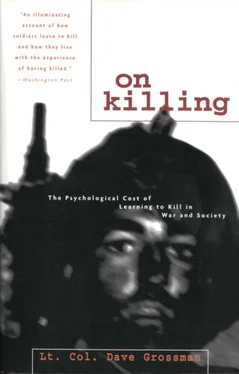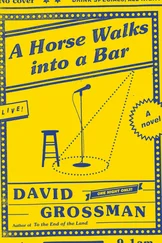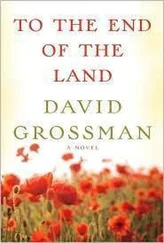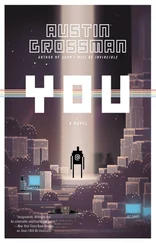• Similarity to the learner. You perceive that the role model has a key trait that makes him/her similar to you.
• Social power. The role model has the power to reward (but does not necessarily do so).
• Status envy. You envy the role model’s receipt of rewards from others.
An analysis of these processes can help us understand the role of the drill sergeant as a role model in violence enabling in military training, and it can help us understand why a new type of violent role model is so popular among America’s youth.
Violence, Role Models, and Drill Sergeants in Basic Training
From this time on I will be your mother , your father , your sister , and your brother . I will be your best friend and your worst enemy. I will be there to wake you up in the morning, and I will be there to tuck you in at night. You will jump when I say “frog” and when I tell you to s*** your only question will be “ What color.” IS THAT CLEAR?
— Drill Sergeant G., Fort Ord, California, 1974
Lives there a veteran who cannot close his eyes and vividly visualize his drill sergeant? Over the years a hundred bosses, teachers, professors, instructors, sergeants, and officers have directed various aspects of my life, but none has had the impact that Drill Sergeant G. had on that cold morning in 1974.
The armies of the world have long understood the role of social learning in developing aggression in their soldiers. In order to do this their venue has been basic training, and their instrument has been the drill sergeant. The drill sergeant is a role model. He is the ultimate role model. He is carefully selected, trained, and prepared to be a role model who will inculcate the soldierly values of aggression and obedience. He is also the reason that military service has always been a positive factor for young people from delinquent or disadvantaged backgrounds.
He is invariably a decorated veteran. The glory and recognition bestowed on him are things that the trainees deeply envy and desire. Within the young soldiers’ new environment the drill sergeant has enormous and pervasive authority, giving him social power. And the drill sergeant looks like his charges. He wears the uniform. He has the haircut. He obeys orders. He does the same things. But he does all of them well.
The lesson that the drill sergeant teaches is that physical aggression is the essence of manhood and that violence is an effective and desirable solution for the problems that the soldier will face on the battlefield. But it is very important to understand that the drill sergeant also teaches obedience. Throughout training the drill sergeant will not tolerate a single blow or a single shot executed without orders, and even to point an empty weapon in the wrong direction or to raise your fist at the wrong time merits the harshest punishment. No nation will tolerate soldiers who do not obey orders on the battlefield, and the failure to obey orders in combat is the surest route to defeat and destruction.
This is a centuries-old, perhaps millennia-old, process that is essential to ensuring that our soldiers survive and obey in combat. In the Vietnam era the drill sergeant communicated a glorification of killing and violence of an intensity never before seen. We did it intentionally. We did it calculatingly. And as long as we have armies we must continue to provide some form of appropriate role model if we want our sons and daughters to survive on future battlefields.
Role Models, the Movies, and a New Kind of Hero
If such “manipulation of the minds of impressionable teenagers” is a necessary evil, accepted only reluctantly and with reservations for combat soldiers, how should we feel about its indiscriminate application to the civilian teenagers of this nation? For that is what we are doing through the role models being provided by the entertainment industry today. But while the drill sergeant teaches and models aggression in obedience to law and authority, the aggression taught by Hollywood’s new role models is unrestrained by any obedience to law. And while the drill sergeant has a profound one-time impact, the aggregate effect of a lifetime of media may very well be even greater than that of the drill sergeant.
It has long been understood that movies can have a negative effect on a society through this role-modeling process. For example, the movie Birth of a Nation has been widely and plausibly credited with the revival of the Ku Klux Klan. But in general, throughout its golden age Hollywood intuitively understood its potential for doing harm and acted responsibly by providing positive role models for society. In the war movies, westerns, and detective movies of the past, heroes only killed under the authority of the law. If not, they were punished. In the end the villain was never rewarded for his violence, and he always received justice for his crimes. The message was simple: No man is above the law, crime does not pay, and for violence to be acceptable it must be guided by the constraints of the law. The hero was rewarded for obeying the law and channeling his desire for vengeance through the authority of the law. The viewer identified with the hero and was vicariously reinforced whenever the hero was. And the audience members left the theater feeling good about themselves and sensing the existence of a just, lawful world.
But today there is a new kind of hero in movies, a hero who operates outside the law. Vengeance is a much older, darker, more atavistic, and more primitive concept than law, and these new antiheroes are depicted as being motivated and rewarded for their obedience to the gods of vengeance rather than those of law. One of the fruits of this new cult of vengeance in American society can be seen in the Oklahoma City bombing, and if we look into the mirror provided by the television screen, the reflection we see is one of a nation regressing from a society of law to a society of violence, vigilantes, and vengeance.
And if America has a police force that seems unable to constrain its violence, and a population that (having seen the videotape of Rodney King and the LAPD) has learned to fear its police forces, then the reason can be found in the entertainment industry. Look at the role models, look at the archetypes that police officers have grown up with. Clint Eastwood’s Dirty Harry became the archetype for a new generation of police officers who were not constrained by the law, and when Hollywood’s new breed of cop was rewarded for placing vengeance above the law, the audience was also vicariously rewarded for this same behavior.
Feeding their audience a steady stream of vicarious reinforcement through such vengeful, lawless role models, these movies prepare our society for the acceptance of a truly hideous and sociopathic brand of role model. The essence of this new brand of role model is a brutal and usually supernaturally empowered murderer who is depicted as graphically torturing and murdering innocent victims.
In these movies there is usually no real attempt to paint the victims as being criminals; it is generally acceptable to justify their deaths as deserved due to the snobbery or social slights they have inflicted on others (as in the classic horror movie Carrie, which has spawned dozens more, cast from the same mold) or due to their membership in some social group or class held in scorn by the bulk of the youthful target audience. In these movies the viewers receive reinforcement by vicariously killing the people in their lives who have socially snubbed or otherwise “dissed” (shown disrespect to) them. And, in real life, the youth and the gangs of America escalate violence in our nation as they learn to take the law into their own hands and mete out “justice” to those who “diss” them.
Читать дальше







